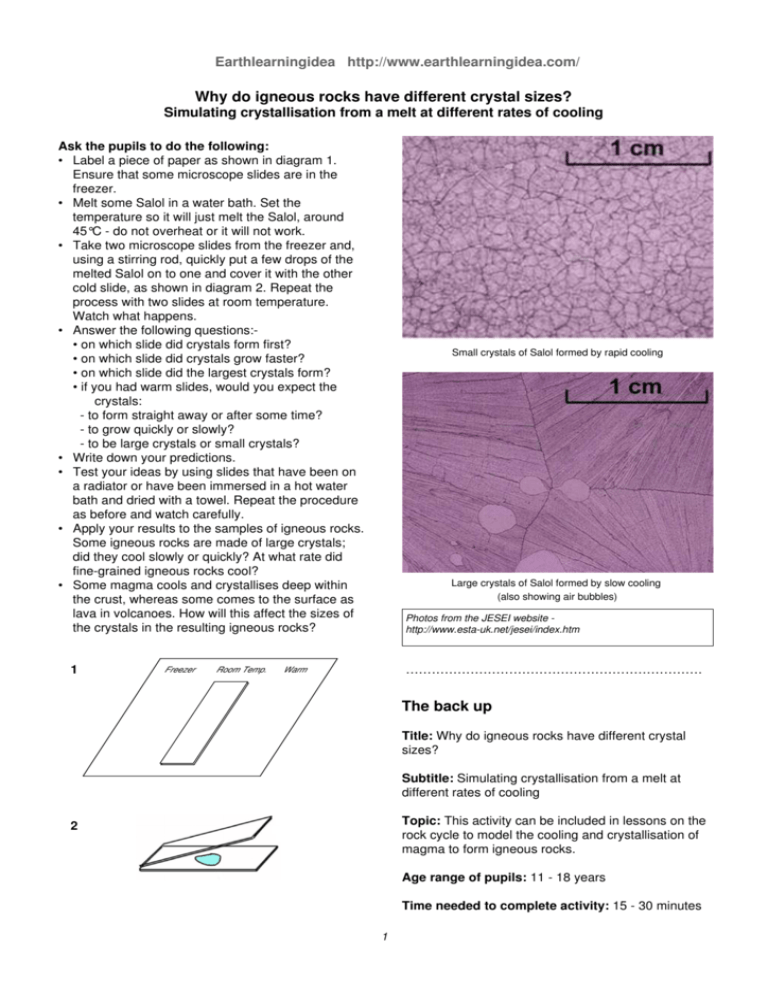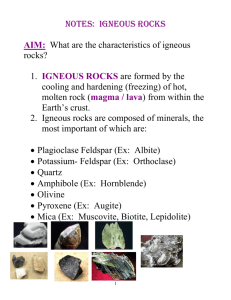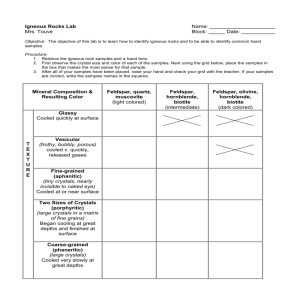Why do igneous rocks have different crystal sizes?
advertisement

Earthlearningidea http://www.earthlearningidea.com/ Why do igneous rocks have different crystal sizes? Simulating crystallisation from a melt at different rates of cooling Ask the pupils to do the following: • Label a piece of paper as shown in diagram 1. Ensure that some microscope slides are in the freezer. • Melt some Salol in a water bath. Set the temperature so it will just melt the Salol, around 45°C - do not overheat or it will not work. • Take two microscope slides from the freezer and, using a stirring rod, quickly put a few drops of the melted Salol on to one and cover it with the other cold slide, as shown in diagram 2. Repeat the process with two slides at room temperature. Watch what happens. • Answer the following questions:• on which slide did crystals form first? • on which slide did crystals grow faster? • on which slide did the largest crystals form? • if you had warm slides, would you expect the crystals: - to form straight away or after some time? - to grow quickly or slowly? - to be large crystals or small crystals? • Write down your predictions. • Test your ideas by using slides that have been on a radiator or have been immersed in a hot water bath and dried with a towel. Repeat the procedure as before and watch carefully. • Apply your results to the samples of igneous rocks. Some igneous rocks are made of large crystals; did they cool slowly or quickly? At what rate did fine-grained igneous rocks cool? • Some magma cools and crystallises deep within the crust, whereas some comes to the surface as lava in volcanoes. How will this affect the sizes of the crystals in the resulting igneous rocks? 1 Freezer Room Temp. Small crystals of Salol formed by rapid cooling Large crystals of Salol formed by slow cooling (also showing air bubbles) Photos from the JESEI website http://www.esta-uk.net/jesei/index.htm …………………………………………………………… Warm The back up Title: Why do igneous rocks have different crystal sizes? Subtitle: Simulating crystallisation from a melt at different rates of cooling Topic: This activity can be included in lessons on the rock cycle to model the cooling and crystallisation of magma to form igneous rocks. 2 Age range of pupils: 11 - 18 years Time needed to complete activity: 15 - 30 minutes 1 Earthlearningidea http://www.earthlearningidea.com/ Pupil learning outcomes: Pupils can: • see that the crystals form first on the cold slide; • see that the crystals grow fastest on the cold slide; • see that the largest crystals form on the slide which is at room temperature; • predict that, on a warm slide, the crystals will not form immediately, will grow slowly and be large; • discover a link between cooling rates and the sizes of crystals that are produced; • interpret crystal sizes in a variety of igneous rocks. The magma cooled slowly to form the rocks with large crystals and quickly in the lavas where the crystals are too small to see with the naked eye; • identify intrusive rocks with large crystals and extrusive rocks with small crystals; • use the crystal sizes to predict the relative depths at which igneous rocks crystallised; • realise that cooling rate is not the only variable affecting the crystallisation of igneous rocks. Following up the activity: Pupils could examine specimens of igneous rock, preferably with polished surfaces, to observe the size, shape and relationships between crystals. Experimental modelling of the crystallisation of two chemicals may be demonstrated by dissolving equal quantities of copper sulphate and potassium nitrate in warm dilute sulphuric acid. The solution is cooled and poured into a watch glass to crystallize. For safety reasons this must be done by the teacher and not the pupils. (Pupils are not allowed to use potassium nitrate). Underlying principles: • Many kilometres below the surface of the Earth the temperature is high enough to cause partial melting. The magma produced rises upwards because it is less dense than the overlying rocks. • Crystallisation of the magma may take place within intrusions at different levels of the crust or, if extrusion takes place, at the surface. Intrusions may later be exposed at the surface by weathering and erosion processes. • Igneous rocks form from melts which may exceed 1000° Celsius. This activity models the behaviour of a cooling magma, but at a much lower temperature (around 40°C). • Extrusive lavas take seconds to weeks to cool and crystallise whereas intrusive magmas cool and crystallise in thousands to millions of years. • No igneous rock is identical to another unless they have formed from the same melt. They all have unique signatures. Context: The Salol crystals provide a model to represent the size of crystals as a function of cooling. The largest crystals of Salol are formed from the slowest cooling melt and the smallest crystals from the fastest-cooling melt. Igneous rocks show a similar behaviour. Coarse-grained rocks, like granite, are formed by slow cooling at depth, whereas volcanic rocks, like basalt, are fine-grained and the lava cooled quickly. Note: • Igneous rocks are classified according to their mineral content as well as their crystal size. • Salol crystals mis-represent real rock textures. Igneous rocks typically contain several minerals which crystallise at different times and rates and so have different sizes. Salol crystals grow radially from a nucleus, whereas most silicate minerals in igneous rocks grow concentrically. • Cooling rate is not the only factor to consider when studying crystallisation from melt; other factors include mineral content, water content, position in the crust and time. • Sometimes this activity ‘doesn’t work’ because the liquid Salol can ‘supercool’ and cool down to room temperature without crystallising. When it does eventually crystallise, it is at the ‘wrong’ temperature so gives the ‘wrong’ result. The method suggested reduces the likelihood of this by: • suggesting that the Salol is only just melted (if it is heated to as much as 100°C it is more likely to ‘supercool’) • using two really clean slides to ‘sandwich’ the Salol (dirt of imperfection of the slides is likely to trigger crystallisation) • doing the activity twice (once using freezer/room temperature slides, the second time using warm slides. At least one ‘run’ is likely to give the ‘right’ answer.) Thinking skill development: Slow cooling resulting in large crystals and fast cooling in small crystals develops a pattern. Some igneous rocks contain large crystals (phenocrysts) causing cognitive conflict. Explaining the results obtained involves metacognition. Applying the results of the activity to the crystals in igneous rocks involves bridging. Resource list: • Salol (phenyl salicylate), approximately 5g • boiling tube • 250ml beaker • 6 microscope slides (plus some spares) • stirring rod • safety goggles • hand lens or magnifying glass • digital microscope if available • hot water (heated in a kettle or by a gas burner) • access to a freezer or freezer section of a refrigerator • sheet of coloured paper or card (preferably dark) 2 Earthlearningidea http://www.earthlearningidea.com/ Source: This activity is based on ESTA’s ‘Magma Introducing Igneous Processes’ in ‘The Science of the Earth 11-14’ series. It is also incorporated into the workshop titled ‘The Dynamic rock cycle’, Earth Science Education Unit, http://www.earthscienceeducation.com • samples of igneous rocks of various grain sizes (e.g. granite, microgranite, rhyolite, gabbro, dolerite, basalt). Useful links: Earth Science Education Unit. Three video clips of Salol crystals forming are available in the ‘Resources for Schools’ section on this website:http://www.earthscienceeducation.com Joint Earth Science Education Initiative http://www.esta-uk.net/jesei/index.htm © Earthlearningidea team. The Earthlearningidea team seeks to produce a teaching idea regularly, at minimal cost, with minimal resources, for teacher educators and teachers of Earth science through school-level geography or science, with an online discussion around every idea in order to develop a global support network. ‘Earthlearningidea’ has little funding and is produced largely by voluntary effort. Copyright is waived for original material contained in this activity if it is required for use within the laboratory or classroom. Copyright material contained herein from other publishers rests with them. Any organisation wishing to use this material should contact the Earthlearningidea team. Every effort has been made to locate and contact copyright holders of materials included in this activity in order to obtain their permission. Please contact us if, however, you believe your copyright is being infringed: we welcome any information that will help us to update our records.If you have any difficulty with the readability of these documents, please contact the Earthlearningidea team for further help. Contact the Earthlearningidea team at: info@earthlearningidea.com 3









